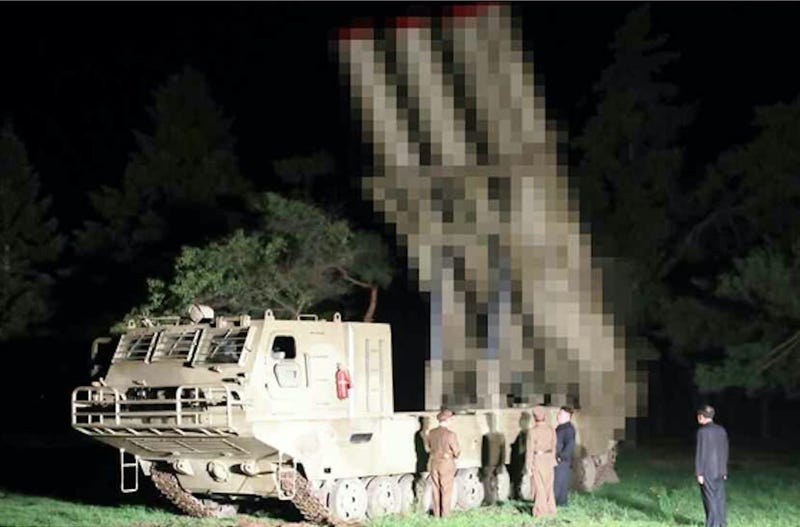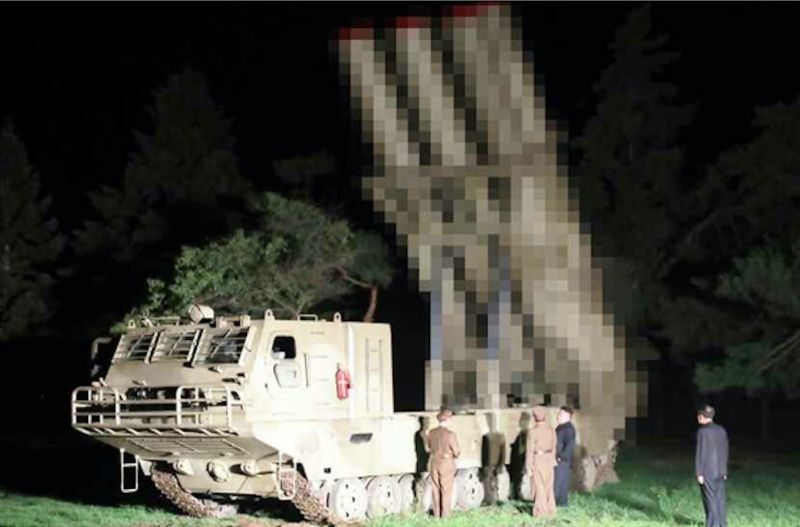
 Foxtrot AlphaTech and news from the world of modern defense.
Foxtrot AlphaTech and news from the world of modern defense.North Korea has conducted a round of long range rocket tests designed to kick down the door and destroy ballistic missile defenses protecting South Korea. The new rockets fly under U.S. high altitude missile defense weapons, paving the way for further missile strikes. The missiles are proof that, far from disarming, the country with an economy smaller than Hawaii’s is prepared to do what it takes to keep South Korea—and the wider world—in fear of its missiles.
On July 31 and August 1, North Korea tested what it described as a “newly-developed large-caliber multiple launch guided rocket system”. That’s quite a mouthful for Pyongyang, which can be pretty taciturn about the weapons it tests. The Rodong Sinmun, a North Korean state news outlet, described the first test as follows:
Being briefed on the system, Kim Jong Un, Supreme Leader of the Party, state and armed forces of the DPRK, learnt in detail about its development.
The test-fire took place in his presence.
The test-fire scientifically confirmed that the tactical data and technical characteristics of the new-type large-caliber guided ordnance rocket reached the numerical values of its design, and verified the combat effectiveness of the overall system.
After learning about the result of the test-fire, he said that it is very great and it would be an inescapable distress to the forces becoming a fat target of the weapon.
He repeatedly expressed satisfaction over the result of the test-fire and highly appreciated the feats of the working class in the fields of national defense science and munitions industry who has made another wonderful Korean-style multiple launch rocket system of great strategic significance conducive to considerably boosting the combat capability of the People’s Army.
Great, I guess. But what does it mean?
Artillery rockets are used by many countries as a counterpart to traditional howitzer artillery. The U.S. and many of its allies use 227-millimeter rockets for their MLRS and HIMARS launch vehicles, Russia has its new 300-millimeter Tornado-S rockets, and China has the 300-millimeter A300 rocket system. Rockets can fly farther than artillery shells, and ripple fired from a launch system can sow destruction over a wide area. The introduction of GPS has made rockets even more accurate, with the American GMLR precision-guided rocket capable of hitting bullseyes at 85 miles.
Advertisement
Artillery rockets have much shorter ranges than ballistic missiles, which can fly up to thousands of miles. Ballistic missiles loft their warheads on a high ballistic arc, sending them into low earth orbit before reentering the atmosphere. Artillery rockets on the other hand fly much lower, staying well within Earth’s atmosphere. If a ballistic missile is a pop fly, an artillery rocket is a line drive.
In recent years, North Korea has developed an arsenal of ballistic missiles. North Korea is believed to have up to six different short range ballistic missiles capable of striking South Korea and parts of Japan. At longer, so-called “medium” ranges it has the Pukkuksong-2, a missile that can strike Japan and U.S. bases in Japan. At even farther ranges it has the BM-25 Musudan missile to hit air and naval bases on the U.S. territory of Guam.
Advertisement
Last but not least it has three different types of intercontinental ballistic missiles that can, to varying degrees, drop nuclear warheads on the continental United States.
In response to Pyongyang’s missiles the United States has deployed the Terminal High Altitude Area Defense system, or THAAD, to South Korea. THAAD, along with the AN/TPY-2 high altitude radar system, is designed to knock down incoming ballistic missile warheads at altitudes of up to 93 miles. This is not great news for North Korea, whose ballistic missiles and their nuclear warheads are an insurance policy for the regime of Kim Jong un.
Advertisement
The artillery rockets—and their blurred out launchers—bear considerable resemblance to other heavy rocket artillery systems. As rocket artillery, they will also fly the same flight profile. According to South Korean officials who monitored the tests, the rockets flew about 155 miles and as high as 19 miles. That’s almost far enough to reach the THAAD battery in South Korea, while flying too low for the vaunted anti-missile system to intercept it. Far from being checked by THAAD, North Korea has simply developed a new weapon to destroy it. Once the THAAD sites protecting South Korea are destroyed the north’s ballistic missiles have a greater chance of penetrating remaining defenses.

Advertisement
It goes like this: North Korea deploys ballistic missiles. The United States deploys anti-missile missiles in response. North Korea responded by developing long range rockets to take out the anti-missile missiles. Now the U.S. must act to protect THAAD, so the next logical step is to deploy anti-rocket missiles to take out the anti-missile rockets threatening the anti-missile missiles, which protect South Korea from the North’s ballistic missiles.
North Korea, while sometimes written off as a bumpkin state, is a canny adversary that is always thinking in terms of move vs. counter-move. The North spent a lot of money on its ballistic missiles and nuclear weapons, and isn’t about to allow them to be made obsolete by those meddling Americans. The United States is engaged in a deadly arms race with one of the poorest countries in the world, and the other country is holding its own quite well.













